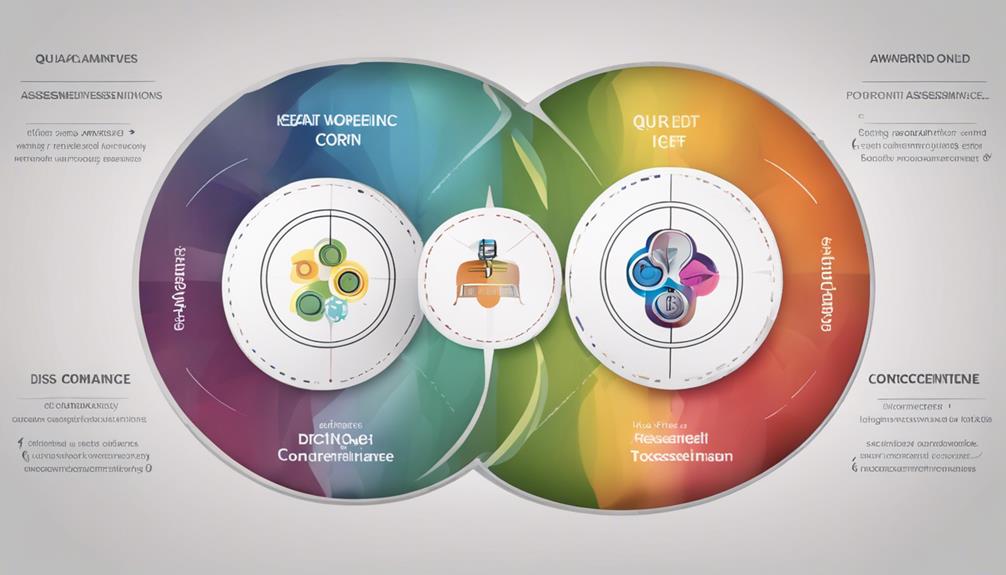In delving into the complexities of DISC assessment findings, it’s interesting to observe that more than 30 million individuals globally have completed the test to discover more about their personalities and behaviors.
Understanding the implications of your scores can pave the way for a deeper comprehension of how you interact with others and navigate various aspects of your life. By unraveling the layers of Dominance, Influence, Steadiness, and Conscientiousness, we unlock a roadmap to not only understanding ourselves better but also honing our relationships and professional endeavors.
Key Takeaways
- Interpret DISC scores to adjust communication styles effectively.
- Utilize DISC results for team construction and conflict resolution.
- Identify trait patterns for personalized growth and enhanced communication.
- Tailor communication approaches based on profile patterns for optimal outcomes.
Four Primary DISC Personality Traits
In analyzing the four primary DISC personality traits, we uncover fundamental aspects of human behavior and interaction styles. The DISC assessment results offer valuable insights into an individual's natural behavioral tendencies. The four traits – Dominance, Influence, Steadiness, and Conscientiousness – encapsulate a range of personality characteristics that impact how individuals work and communicate.
Dominance reflects assertiveness and a drive for results. Individuals high in Dominance tend to be decisive and direct in their approach. Influence highlights sociability and enthusiasm, with a focus on building relationships and influencing others positively. Steadiness emphasizes cooperation and reliability, showcasing a preference for stability and harmonious environments. Conscientiousness signifies precision and attention to detail, indicating an individual's methodical and systematic work style.
Understanding these four primary traits is crucial for navigating various interpersonal dynamics and work environments effectively. By recognizing and appreciating the diverse ways in which these traits manifest in individuals, we can enhance communication, collaboration, and overall team performance.
Interpreting DISC Assessment Scores

Upon examining DISC assessment scores, one gains valuable insights into individuals' distinct personality traits and their implications for effective communication and collaboration.
Interpreting DISC assessment scores involves understanding high and low scores, which indicate the strength of specific personality traits. High scores, above 50, suggest a pronounced tendency towards that trait, influencing behavior and work styles. Conversely, low scores below 50 signify a lesser emphasis on that particular trait.
Extreme scores highlight pronounced behavioral characteristics that significantly impact how individuals approach tasks and interact with others. By interpreting these scores, individuals can adapt their communication styles, leverage their strengths, and tailor their approaches to better collaborate with colleagues.
Understanding the nuances of DISC assessment scores allows individuals to harness their unique personality traits effectively in various settings, fostering improved teamwork and productivity.
DISC Assessment Charts Overview
How do DISC assessment charts provide a visual representation of trait scores and combinations for individuals?
DISC assessment charts offer a comprehensive visual depiction of an individual's traits. The four-quadrant circle chart showcases trait scores, with the dot symbolizing the average score across traits, enabling a quick understanding of the overall trait distribution.
For a more detailed analysis, the 12-slice circle chart dives deeper into trait combinations, providing insights into how different traits interact within an individual. Profile graphs further enhance this by presenting trait scores in line charts, offering a breakdown of adapting, natural, and overall profiles.
These charts play a crucial role in visualizing scores, helping individuals and professionals identify their strengths, tendencies, and areas for development. By examining these visual representations, individuals can gain a clearer understanding of their unique trait combinations and how they influence their behaviors and interactions.
Applying DISC Results in Work

By understanding how to apply DISC results in the workplace, we can effectively tailor communication styles to individual traits, fostering enhanced collaboration and productivity. Utilizing DISC personality test results can aid in building effective teams by recognizing and leveraging diverse strengths within the group. Additionally, these insights guide targeted training and development opportunities, ensuring that employees receive the support they need to excel.
Understanding DISC scores is instrumental in conflict resolution and decision-making processes within a team. By recognizing the various communication styles and preferences of team members, conflicts can be addressed more effectively, leading to smoother resolutions. Moreover, leveraging DISC profiles in the workplace improves teamwork dynamics, as individuals learn to appreciate and adapt to each other's working styles.
Understanding DISC Profile Patterns
Understanding the unique combinations of Dominance, Influence, Steadiness, and Conscientiousness traits in DISC profile patterns provides valuable insights into individual behavioral tendencies and communication styles. Individuals may exhibit varying degrees of these traits, leading to diverse profile patterns that range from balanced to more pronounced concentrations. Recognizing these patterns is instrumental in tailoring strategies for personal and professional development. By identifying consistent patterns in DISC profiles, individuals can gain a deeper understanding of their preferred ways of interacting and making decisions. This awareness allows for adjustments in communication styles and behavior to enhance effectiveness in various situations. Below is a table illustrating how different trait combinations manifest in DISC profiles:
| Dominance | Influence | Steadiness |
|---|---|---|
| High | Low | Medium |
| Low | High | High |
| Medium | Medium | Low |
Frequently Asked Questions
How Do You Interpret DISC Results?
We interpret DISC results by analyzing the blend of Dominance, Influence, Steadiness, and Conscientiousness traits. Understanding the mix, rather than extreme scores, is key. Reports simplify with abbreviations like D or SC. Leveraging strengths and addressing weaknesses effectively is crucial.
How Do You Read a DISC Assessment Chart?
When we read a DISC assessment chart, we observe the dot indicating the average scores and profile graphs illustrating trait strengths. These visuals help us comprehend individual tendencies, fostering effective interpretation for tailored communication strategies.
What Is the Rarest Disc Profile?
We've discovered the rarest DISC profile often blends high Conscientiousness with low Dominance. This unique mix yields meticulousness without forcefulness. It's a balance of precision and caution, shedding light on how individuals with this combo navigate work and relationships.
What Are the 4 DISC Personality Types?
We understand the 4 DISC personality types as Dominance (D), Influence (I), Steadiness (S), and Conscientiousness (C). Each type reflects distinct characteristics crucial for self-awareness and effective interpersonal interactions.
What Do the Results of a DISC Assessment Mean and How to Interpret Them?
Understanding your DISC assessment results can provide valuable insights into your communication style, work preferences, and overall behavior. The results indicate your dominant personality traits, strengths, and areas for potential growth. By interpreting these results, you can gain a better understanding of yourself and how to interact more effectively with others.
Conclusion
In understanding our DISC assessment results, we uncover the intricate tapestry of our personalities. Just as each color in a painting contributes to the overall masterpiece, each trait in our profile adds depth and richness to who we are.
Embrace the diversity within yourself, for it's what makes you unique and valuable. Let your strengths shine and work on areas for growth, for in this self-discovery journey lies the path to personal and professional fulfillment.
Felicity, our Author, pens in-depth articles and guides that delve into the heart of personal discovery. Her narrative-driven approach weaves together theory, practice, and personal anecdotes, making the journey of self-exploration both relatable and inspiring. Felicity’s contributions help illuminate the path for those seeking a deeper understanding of themselves and their relationships.










